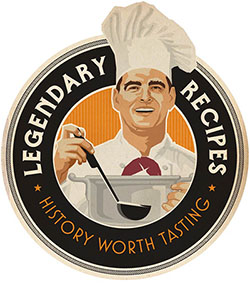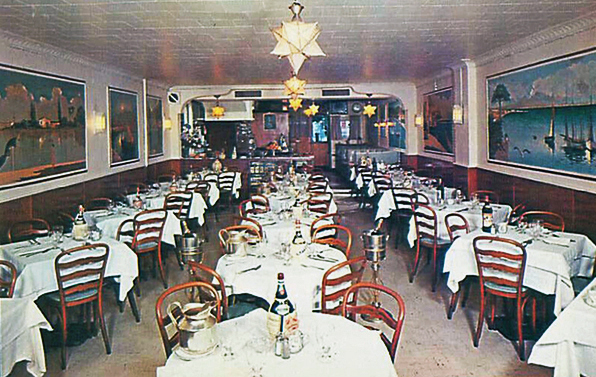Nicholas (Nick) Toce was an experienced hand in the restaurant business by the time he and actor Albert Raymo opened Adano Italian Restaurant in New York City’s theater district in 1945. Through most of the 1930s Toce had owned and operated the Village Brewery, a lively restaurant and nightspot at 186 West 4th Street in Greenwich Village, and in 1938 he’d converted its main dining room into the golf-themed “19th Hole,” with pictures of famous golfers on the walls and an indoor driving range downstairs. in 1942 he’d relocated to Hartford, Connecticut, for a brief stint as the owner of the Colony Restaurant at 506 Farmington Avenue. But in 1945 Toce made his way back to New York City, bought Lorraine’s Restaurant at 115 West 48th Street, and, in partnership with Raymo, turned it into Adano.
Toce and Raymo drew the name for their restaurant from John Hersey’s novel, A Bell for Adano, which had been published in 1944 and made into a Broadway play the same year. It tells the story of an Italian-American officer in Sicily during World War II who wins the respect and admiration of the citizens of the small town of Adano (based on the real town of Licata) by helping them find a replacement for the town bell that Benito Mussolini’s Fascists had melted down for rifle barrels. Hersey’s book was awarded the Pulitzer Prize for fiction in 1945 and that year was also made into a major motion picture.
The Broadway production of A Bell for Adano opened at the Cort Theatre on December 6, 1944. Fredric March was cast in the lead role as Major Victor Joppolo, and Raymo in a minor but important role as Pietro Afronti, a belligerent cart-driver. Adano, appropriately, was right across from the Cort (today the James Earl Jones Theatre) at 138 West 48th, and in all likelihood Raymo, who was also a talented artist, painted the mural-like scenes of Italy that decorated the restaurant’s walls. But Raymo seems to have gone his own way soon after A Bell for Adano closed ion Broadway in October 1945.
Toce, who was not yet even a teenager when he came to the United States from Italy in 1900, had served such distinctly American foods as fried chicken in the restaurants he’d previously owned. But with Adano he finally got the chance to go full-bore Italian. Approached in 1937 by the “Inquiring Photographer” of the New York Daily News, he’d made a case for the superiority of his native cuisine. “Italian food is most appetizing because it is cooked in good oils and is generally a blend of the finest ingredients,” he explained. “In other words, a good Italian cook is a good dietician.”
Toce saw to it that the generous assortment of antipasti awaiting guests as they entered Adano’s dining room—including fried zucchini, stuffed artichokes, stuffed mushrooms, and stuffed peppers—was prepared from scratch each morning. Likewise, he insisted that all the pasta served at the restaurant be made on the premises, and there were lots of pasta dishes to be had, including lasagna, manicotti, and spaghetti with either red or white clam sauce. Other entrées included such Italian mainstays as Chicken Romano and Veal Rollatini. For dessert the best choice was always the house-made rum cake, an Adano specialty.
In 1951 Toce died at age 63 after what the New York Times described as “a long illness.” At that point his widow, Mamie, took over operations at Adano, backed by Claudio Stagnaro, the restaurant’s Genoa-born head chef.
Adano ambled through the years ahead quite successfully, but as Mamie turned 70 in the mid-1960s she evidently began to think about retiring. In 1967 Craig Claiborne of the New York Times gave Adano a one-star review, writing that the menu was “by and large standard” and that the food was “prepared and seasoned with a somewhat heavy hand.”
Adano closed the following year, with its fixtures and furnishings sold at auction.
Mamie Toce died in New York City in 1982 at age 88.
Famous Patrons of Adano Italian Restaurant
- John Hersey
- John McGiver

Spaghetti and Clam Sauce Adano
Adana Italian Restaurant was a fixture in New York City's theater district from 1945 to 1968. Over the years patrons could order spaghetti with either red or white clam sauce, but Nicholas (Nick) Toce, one of the restaurant's founders, preferred the red-sauce version and deemed this simple recipe (adapted here from the original) to be one of Adano's best dishes.
Ingredients
- 1 dozen littleneck clams
- 1 large clove garlic, peeled and thinly sliced
- 3 1/2 tablespoons extra-virgin olive oil
- 2 1/2 cups crushed San Marzano tomatoes
- 1 teaspoon chopped flat-leaf parsley
- Kosher salt, to taste
- Freshly ground black pepper, to taste
- 1 pound spaghetti
Instructions
Wash the clams by scrubbing the outsides of the shells under cold running water until they are clean, making sure that they are closed and unbroken. (Discard any clams that aren’t closed.)
In a large bowl, combine about 4 1/2 cups very cold water with about 2 1/2 tablespoons salt (to match the salinity of seawater) and whisk until the salt is dissolved. Add the clams to the water, making sure that they are submerged. Transfer the bowl to the refrigerator and let the clams sit in the saltwater bath for at least 2 hours and up to 12 hours (the longer the better).
Remove the clams with your hands, being careful not to disturb any of the sand or other deposits at the bottom of the bowl, and rinse them under cold running water. Discard any broken or open clams.
Shuck the clams by holding each clean clam in a kitchen towel in your palm and carefully prying open the shell with a small, sharp knife—or a knife made especially for shucking—by moving the blade around until the top of the shell has separated and can be pulled up. Working over a bowl, use the knife the remove the clam meat and the muscle from each side of the shell, letting any juice or brine drop into the bowl.
Chop the clam meat into small pieces and reserve.
In an 11- to 12-inch skillet over medium high-heat, heat the olive oil and sauté the garlic in it until the garlic it is lightly golden, about 1 minute. Add the clam juice, tomatoes, parsley, salt, and pepper. Reduce heat to low and simmer, stirring occasionally, for 45 minutes.
When the sauce is close to being done, bring a large pot of salted water to a boil. Add the spaghetti to the boiling water and cook according to the package instructions.
When the spaghetti is a few minutes from being done, add the crab meat to the sauce, increase the heat to medium-high, and cook for 1 to 2 minutes.
Drain the spaghetti, plate, and pour clam sauce over each portion. Serve immediately. Use no cheese.
Notes
While the original recipe from Adano called for fresh littleneck clams, two 6 1/2-ounce cans of chopped clams (with the juices reserved) may be substituted.










No Comments